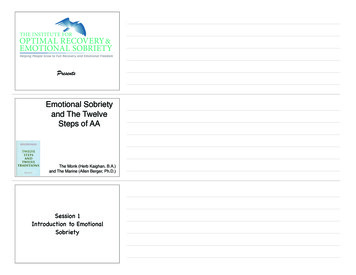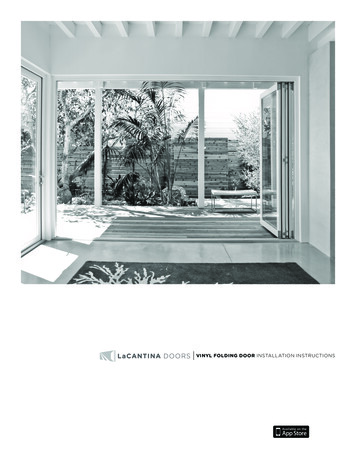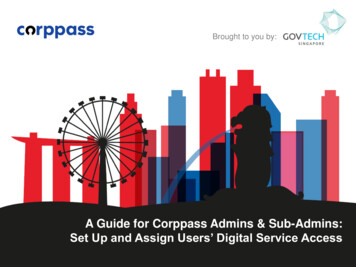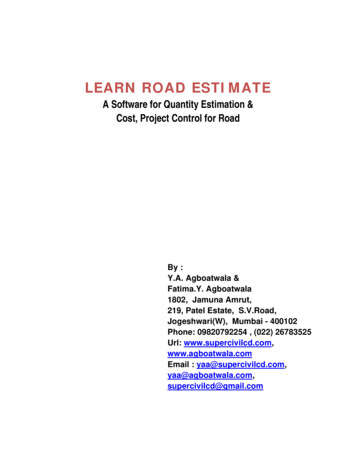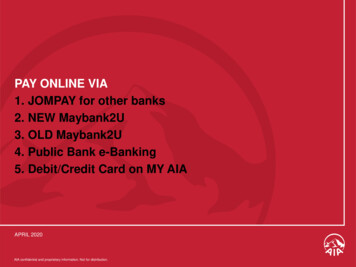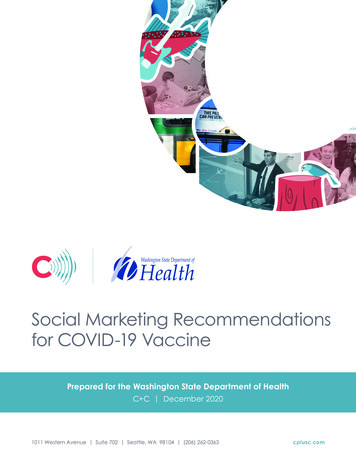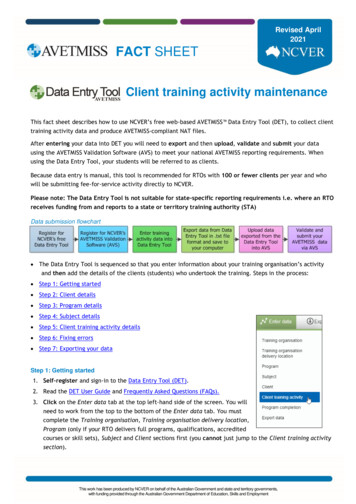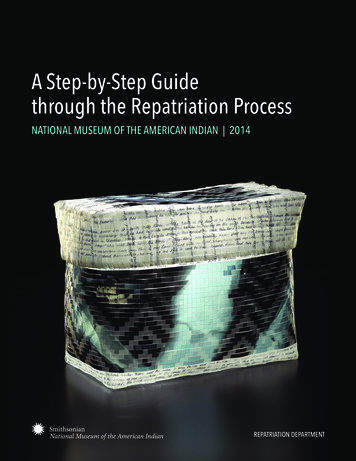
Transcription
A Step-by-Step Guidethrough the Repatriation ProcessNAtioNAl MuSeuM of the AMeRicAN iNdiAN 2014RePAtRiAtioN dePARtMeNt
National Museum of the American indian Mission Statementthe National Museum of the American indian (NMAi) is committed to advancingknowledge and understanding of the Native cultures of the Western hemisphere—past,present, and future—through partnership with Native people and others. the museumworks to support the continuance of culture, traditional values, and transitions incontemporary Native life.The NMAI’s mission emphasizes partnerships with the Native cultures of the Western Hemisphere, recognizingour special responsibility to support and enhance the development, maintenance, and perpetuation of Nativeculture and community. This is accomplished through direct consultation, collaboration, and cooperation withcontemporary Native peoples throughout the hemisphere who are culturally affiliated with the museum’s diverseethnographic and archaeological collections.1
Guidelines for Repatriation from theNational Museum of the American indianThe NMAI Repatriation Department welcomes your interest in our repatriation program. We are adepartment within the NMAI’s Museum Scholarship Group, located at the museum’s Cultural Resources Centerin Suitland, Maryland.Repatriation is the process whereby certain types of Native American cultural items are returned to linealdescendants, culturally affiliated Indian tribes, Alaska Native villages and corporations, and Native Hawaiianorganizations. Human remains, funerary objects, sacred objects, and objects of cultural patrimony are legallydefined categories of items that may be considered for repatriation. Additionally, in accordance with longstandingSmithsonian policy, the NMAI may return any objects acquired by or transferred to the NMAI illegally.This manual will guide you step by step through the repatriation process, from gathering the information neededto make a formal request to the successful repatriation of your cultural items.NMAI Cultural Resources Center (CRC), Suitland, Maryland2
T3
4
T5
NMAi Repatriation ProceduresSteP oNe: iNfoRMAl iNquiRy foR RePAtRiAtioN iNfoRMAtioNThe repatriation process usually begins with a request for a museum inventory of items related to the requestingtribe. The NMAI Repatriation Department welcomes inquiries from Native American tribes, Alaska Native villagesand corporations, Native Hawaiian organizations, and lineal descendants about objects in the collection that maybe eligible for repatriation. Details such as tribal names, geographical areas of interest (e.g. countries, states,counties, provinces, and sites) and particular objects of interest are helpful in guiding the Repatriation Departmentstaff when preparing inventories. Lineal descendants requesting information may contact the RepatriationDepartment about objects in the museum’s collections if there is a belief that descendancy can be established andthe objects of interest pertain to a category addressed in the NMAI Act. Please refer to appendix B of this guide forexamples of repatriation inquiry letters. Requests for information may be made by mail, telephone, fax, or e-mail tothe Repatriation Department (see appendix A for contact information). In response, the Repatriation Departmentwill provide a letter of acknowledgement and any requested collections inventories with related images.SteP tWo: RequeSt foR coNSultAtioN ViSit ANd collectioNS ReVieWA visit to the CRC is an opportunity to initiate the consultation process with Repatriation Department staff, toidentify items for potential claim, and to review the collections in person.eStAbliShiNG tRibAl AuthoRizAtioNIt is at the consultation stage that a formal relationship is established between the NMAI and the tribal communityor lineal descendant. Requests for consultation should be on official tribal letterhead, signed by the head of theNative community government. The letter should name the officially authorized repatriation representative andany individual who will accompany them during their visit. If the request is from a repatriation representative, itmust be accompanied by either a tribal resolution or letter from the head of the Native community governmentdesignating the officially appointed repatriation representative. Please refer to appendix C of this guide forexamples of letters designating authorization of tribal representatives and appendix D for examples of consultationrequest letters. Lineal descendants are not required to send a tribal authorization letter, but they should providedocumentation establishing a relationship to the known individual whose remains, funerary objects, or sacredobjects they intend to claim. Documentation may include genealogical information (e.g. census records, tribalrolls, and birth certificates) or other relevant family history. Once a consultation request is received, NMAIRepatriation Department staff will contact the potential claimant to make the necessary arrangements for acollections visit.ViSitiNG the collectioNSThe NMAI will support two tribal representatives to visit to the CRC in Suitland, Maryland, for consultation,collections review, and documentation for up to two days. All visits for repatriation purposes must be arrangedthrough the Repatriation Department. Additional representatives or repeat visits are always welcome, althoughtheir expenses must be covered by the tribe or the individual travelers.6
JoiNt coNSultAtioN With the NAtioNAl MuSeuM of NAtuRAl hiStoRyBoth the NMAI and NMNH museums hold significant collections of Native American materials; however, eachmuseum operates its own repatriation program. If a requestor is interested in viewing objects in both museumcollections, a jointly funded consultation may be coordinated. Pending funding availability, joint consultationstypically take place over four days, with two days spent at each museum.PRePARiNG foR youR ViSitIn preparation for your visit, please read the attached NMAI Repatriation Policy, located in appendix G of thisguide. Please give careful consideration to the definitions of materials eligible for repatriation, outlined in sectionII.A. of the policy, because any objects claimed for repatriation must meet at least one of these definitions.Be sure to review the museum’s inventory sheets and images to identify objects that you think may have specialsignificance. If the museum inventory for your area is large, we suggest you prioritize your selections to ensureenough time for examining objects that may be especially meaningful to you. Also consider includingdelegation members such as a traditional or religious leader and/or another expert who has the knowledge andskills to identify objects that may fit a repatriation category. Make sure to prepare any questions or concerns thatwe may be able to address during your visit.Prior to your visit, the Repatriation Department staff member assigned to your consultation will send you adetailed itinerary, including travel and lodging information, a consultation schedule, map, and staffcontact information.Travel PreparationsIf the consultation visit is funded by the NMAI, the NMAI will pay for airfare, hotel, per diem, and somemiscellaneous expenses (e.g., baggage fees, taxis, tolls, and parking fees). Repatriation Department staff will assistyou in completing the required travel forms, examples of which are located in appendix I of this guide. Eachmember of the delegation supported by the NMAI will be required to complete these travel forms. If possible,inform staff of any special needs (e.g., wheelchair accessibility, lighting requirements, or filming requests) inadvance of your visit. Please note that changes to the visiting delegation may only be made up to three weeks priorto the consultation date.Air TravelFlight reservations will be booked and paid for by the NMAI. Electronic airline tickets will be issued and theconfirmation number and itinerary will be e-mailed to you.HotelYour hotel rooms will be booked and paid for by the NMAI. Please note that the museum will not coverlong-distance telephone calls, in-room movies, mini-bar charges, alcoholic beverages, or other incidentals.Per DiemThe NMAI provides a per diem for each day of your official travel. Per diem rates are set by the government andare sufficient to cover meals and incidental expenses. Rates are reduced by 25% on the arrival and departure days.Please refer to www.gsa.gov for specific rate information for Washington, DC. Per diem may be sent by electronicfunds transfer (EFT) or check prior to your visit, provided that your paperwork has had sufficient time forprocessing. Please note that an EFT is generally faster than issuing a paper check.7
Ground TransportationYou will be reimbursed for transportation to and from the local airport and your home. If you are using yourpersonal vehicle, your mileage will be reimbursed according to the mileage rate set annually by General ServicesAdministration.We advise you to travel between the airport and your hotel by taxi. Your driver will not volunteer to give you areceipt, so you must ask for one before you leave the taxi if you want to track your expenses. Taxi rides for officialbusiness are reimbursable.You may submit an itemized list of ground transportation expenses and mileage or provide receipts within twoweeks of your visit. Please note that any individual expenses over 75.00 require a receipt.Directions to the CRC from Downtown Washington, DCVia shuttle bus:The Smithsonian Institution runs an hourly shuttle bus between the National Mall and the CRC. If priorarrangements are made, a NMAI Repatriation Department staff member will meet you at the shuttle stop locatedat the northwest corner of 4th Street and Independence Avenue, SW. The staff member will provide you withvisitor passes and will escort you to the CRC, located on the Suitland campus.Via car or taxi: Take South Capitol Street southbound out of the city After about a mile, take a slight left towards Suitland Parkway. Continue straight onto Suitland Parkway. Go 4.3 miles and take the Silver Hill Road exit, westbound. Merge onto Silver Hill Road. The CRC is on your right. A security booth is located at the gate. Tell the guard you are visiting the NMAI Repatriation Department atthe CRC and you will be directed to the right, heading toward the CRC parking lot. After parking, go to themain entrance to check in with security.MARYLAND195Madison Dr SW3rd St SW395SILVERSPRING4th St SWVIRGINIABETHESDA4955050WASHINGTONRonald Reagan Wash.National AirportNMAI4959566Jefferson Dr SWNational Air and SpaceMuseum7th St SW7Ma1acomPot iverRWashington, dc, Area Map6th St SWCulturalResourceCenter301L’enfant PlazaM MetroWve Snd Aryla195National Museum ofthe American IndianIndependence Dr SWSUITLAND5NMAIShuttleStopC St SWVirginHoliday Innia AveD St SWSWFederal CenterMetroMNMAi to cRc Shuttle Stop location Map8
WhAt to exPect duRiNG youR ViSitA consultation visit begins with a welcome and orientation meeting at the CRC. At this meeting we will discussyour priorities and orient you to the repatriation process at the NMAI. Out of privacy and respect, any morespiritually significant items you requested in advance can be moved from the collections storage area to a privateroom for closer review.The human remains and known associated funerary objects within the NMAI collections are stored off-site withother non-NMAI collections at the Smithsonian Institution Museum Support Center (MSC), also located inSuitland, Maryland, per the wishes of the communities who participated in the development and planning of theNMAI. If your delegation chooses to visit the MSC, this can be accommodated.Repatriation Department staff will be available at all times to note any comments you may provide regarding therole of an item within your tribe, or instructions as to how an item should be stored or handled. We may havequestions concerning your tribal history or the geographical areas that were considered primary territory at thetime the objects were in use. Sharing this type of information may expedite research on the background of anobject and its importance to your tribe. The notes taken during your visit will be treated as sensitive informationand will only be shared with critical NMAI staff and the museum’s board of trustees (also referred to herein as theboard) in a report should a repatriation claim be asserted by the tribe or lineal descendant.Ceremonial AccommodationVisitors who wish to smudge before and/or after the collection review may do so in our indoor or outdoorceremonial areas.Photography and FilmingPhotography is permitted during your consultation. Most people who visit the CRC for repatriation consultationsbring cameras. The lighting in the collections storage area is low but adequate for photography and video. Imagesor videos that you may capture during your visit are to be used solely for purposes of presenting them to othertribal members, such as elders who cannot travel, and to aid in repatriation consultations. If you wish, repatriationstaff will assist in photography and can provide a digital copy of photographs taken during the consultation visit.If you choose to document your visit using video, we ask that you fill out the visual media release form located inappendix J of this guide.STeP THRee: FORMAL RePATRIATION ReQUeSTFederally recognized tribes wishing to pursue a repatriation claim must submit a formal written request ontribal letterhead, signed by the tribal representative authorized to act on repatriation matters for the tribe. Linealdescendants must also submit a formal written request, which does not need to be on a tribal letterhead. Examplesof formal request letters for repatriating culturally affiliated objects can be found in appendix E of this guide.A repatriation request should include information from the museum inventory listing, such as the object’s catalognumber and brief description, the repatriation category under which the object is claimed, why it is claimed underthat category, and evidence of cultural affiliation. Repatriation requests should be sent by fax, mail, or e-mail to therepatriation manager (see appendix A for contact information).After receiving the formal repatriation request, the repatriation manager will send a written acknowledgment tothe requestor. The manager will also assess the validity of both the initial evidence provided by the claimant forcultural affiliation or lineal descent and the object’s eligibility based on the legally defined repatriation categories.If the request is incomplete, the repatriation manager will contact the requesting tribe or individual for furtherinformation and clarification.9
STEP FOUR: REVIEW by THE NMAIReSeARch ANd RePoRtRepatriation claims are assigned to a repatriation research specialist who gathers pertinent information andorganizes it into a repatriation research report. The NMAI Act requires the use of the best scientific and historicaldocumentation; the evidence that researchers use includes oral tradition, folklore, linguistics, geography, descent,kinship, archaeology, anthropology, historical patterns of ownership and/or control, expert opinion, and/or otherrelevant information.During the research process, it may be determined that other parties may have an interest in the claim. In suchcases, the Repatriation Department will notify the original claimant and potentially interested parties toexpedite the process and maintain transparency. The potentially interested parties will be provided adequate timeand instruction on how to express their interest for the items under claim. The Repatriation Department staff willdo its best to facilitate any competing claim through consultation during the research phase, if possible. Ifcompeting claims are asserted and not resolved through the report, the NMAI will maintain stewardship untilthe claimants are able to resolve their differences at a tribal level.ReVieWThe final repatriation research report includes a recommendation as to whether the requested object(s) should bedeaccessioned for repatriation. The process by which the report and its recommendations are examined, critiqued,and ultimately accepted or denied involves review by select NMAI staff, the Smithsonian’s Office of GeneralCounsel when needed, and the NMAI’s director. The recommendation is then presented to the board of trusteesfor final determination.boARd of tRuSteeSThe board of trustees has the sole authority and formal responsibility for making decisions regarding repatriationof material in the museum’s collections. Repatriation cases are heard when the full board convenes, whichtypically takes place at least twice a year. The NMAI will notify the claimant of the board’s decision. If the claim isnot approved, the claimant has the right to appeal the decision.iN the eVeNt of AN APPeAlIf the board declines a repatriation claim, the claimant will be notified by letter of their decision. The claimantmay appeal their decision by providing additional or new information to an appeals committee. This informationwill be reviewed and a decision rendered using the process outlined in the NMAI Repatriation Policy, section IV.There is no further appeal beyond the appeals committee.10
STeP FIve: THe PROCeSS OF ReTURNOnce a deaccession has been approved by the board, the Repatriation Department will work with the Nativecommunity representatives or lineal descendant to make arrangements for the return.The NMAI makes its best effort to minimize any financial burden on the claimants for the repatriation. This mayinvolve the NMAI shipping and/or escorting material to a location designated by the tribal representatives, orfunding two community representatives for up to two days to travel to the CRC for the transfer of objects.Typically the museum will supply all packing materials and containers. Special wrappings or specific spirituallysignificant articles (for example, red cloth, sage, cedar, sweetgrass, or other similar materials) may be included atthe tribe’s or individual’s expense.The museum will not be responsible for any costs for special affairs, religious observances, or other materials orservices that the requesting party may deem necessary upon completion of the transfer of repatriated objects tothe tribe.PeSticide tReAtMeNt ANd SAfe hANdliNG of obJectSSome objects in the collection may have been treated with chemical pesticides, a preservation measure often usedby museums in the past. Museum records associated with the objects may not indicate whether such treatmentactually occurred, and there may be no apparent visual indication of chemical residue or treatment on the objects.Therefore, it is advised that skin protection (latex gloves and frequent skin washing) be used when handlingpotentially contaminated objects.If requested by the tribal representative or lineal descendants, the NMAI may be able to test objects for thepresence of certain heavy metals, depending on available funding. This testing involves non-invasive surfacereadings of heavy metals that were commonly used in the past by museums for pest management, namely lead,arsenic, and mercury. Please note that construction materials or environmental contamination may also producea positive result for the presence of certain heavy metals, separate from possible pesticide applications. Test resultswill be provided to the tribal representatives.As a matter of policy, the NMAI does not evaluate the test results for the health effects of any lead, mercury, andarsenic that may be detected on collections objects; we encourage tribes to contact a toxicologist or industrialhygienist for advice on the safety of objects that test positive for those contaminants. At present, the NMAI cannottest for organic pesticide applications or other inorganic pesticides.Once it has been returned to the tribe, additional protective measures may be warranted, depending on the object’sintended use. The elderly, very young, and expectant or nursing mothers should avoid direct skin contact withrepatriated objects that have been treated with pesticides. Do not store repatriated objects that have been treatedwith pesticides near eating utensils or food supplies, or in areas where people regularly eat, sleep, or congregate.Promptly wash exposed skin with hot soapy water after handling or use of repatriated objects that have beentreated with pesticides.iNdiAN tRibeS thAt ARe Not fedeRAlly RecoGNized ANd iNdiGeNouS coMMuNitieS outSideof the uNited StAteSThe NMAI Act and its 1996 amendment address repatriation only for federally recognized Native communities,Alaska Native Corporations, and Native Hawaiian organizations within the United States. However, due to theWestern Hemispheric scope of NMAI collections and in recognition of the United Nations Declaration on theRights of Indigenous Peoples, the museum has developed initiatives that expand upon the provisions outlined inthe NMAI Act and its 1996 amendment. In the spirit of the domestic repatriation initiative, the NMAI11
Repatriation Department actively pursues ways in which to facilitate international repatriation, and will considerrepatriation requests for human remains, associated funerary objects, sacred objects, and objects of culturalpatrimony by affiliated non-federally recognized United States tribes and indigenous communities outside of theUnited States. These cases will be evaluated on a case-by-case basis and will be subject to the same thoroughresearch, reporting, and review process as domestic repatriation claims under the NMAI Act.THANk YOURepatriation is one of the founding tenets of our museum, and the NMAI is proud to be a part of the respectfulreturn of human remains and deeply meaningful objects to their homelands and families. The NMAI hopes thisguide assists you in understanding the repatriation process.12
APPeNdix A NMAi contact listRePAtRiAtioN iNquiRieS MAy be MAde by MAil,telePhoNe, fAx, oR eMAil to:Repatriation DepartmentNational Museum of the American IndianSmithsonian InstitutionCultural Resources Center4220 Silver Hill RoadSuitland, MD 20746-2863Repatriation Manager: 301-238-1548Repatriation Coordinator: 301-238-1554Fax: 301-238-3200Email: NMAI-Repatriation@si.eduWeb: tionNoN-RePAtRiAtioN iNquiRieS foR collectioNViSitS oR iNfoRMAtioN About PARticulARcollectioN obJectS MAy be AddReSSed to:Collections Management DepartmentNational Museum of the American IndianSmithsonian InstitutionCultural Resources Center4220 Silver Hill RoadSuitland, MD 20746-2863Email (preferred): NMAICollections@si.eduTelephone: 301-238-1456Fax: 301-238-3210NoN-RePAtRiAtioN RequeStS foRPhotoGRAPhS oR ARchiVAl docuMeNtSShould be diRected to:Archives CenterNational Museum of the American IndianSmithsonian InstitutionCultural Resources Center4220 Silver Hill RoadSuitland, MD 20746-2863Email: NMAIArchives@si.eduWeb: 13Photo iNquiRieS/PeRMiSSioN RequeStS:Email: NMAIPhotos@si.eduTelephone: 301-238-1400Fax: 301-238-3038foR SAfe hANdliNG MeASuReS:For assistance with safe handling measures such ascleaning or storage of repatriated objects, or foradditional pesticide testing not available at the NMAI,a Native community may wish to contact a universityor the conservation department of a museum. A Nativecommunity may also seek advice or referral at:Office for Safety, Health, and EnvironmentalManagementSmithsonian InstitutionCapital Gallery Building600 Maryland Ave. SW, Suite 7106Washington, DC 20024Telephone: 202-633-2530Fax: 202-633-2683
APPeNdix b Request for information Sample lettersTribal communities and lineal descendants who are interested in repatriation and would like to receiveinformation about the NMAI’s collections of affiliated materials may contact the Repatriation Department.Tribal requests for information should: be addressed to the Repatriation Department; include the name of your tribe; include complete contact information for the recipient; include any variations of the tribal name(s) (e.g., Mewuk and Miwok); specify any particular type(s) of objects of interest by name, for ethnology inventories; and provide information on the counties/areas of interest to your tribe, or the specific site name(s) of interest, forarchaeological inventories.Lineal descendant requests for information should: be addressed to the Repatriation Department; include the complete name and contact information of the lineal descendant; provide the name and description of the object(s) being requested; identify how the lineal descendant is related to the person who owned or cared for the object(s); and include the applicant’s tribal affiliation, if applicable.14
SAMPLE LETTER Tribal Request for Information from Repatriation OfficerAlphabet Tribe of South DakotaAlphabet Tribal Council Building123 Main StreetAnytown, South Dakota 57000605-123-4567September 26, 2014Repatriation DepartmentNational Museum of the American IndianSmithsonian InstitutionCultural Resources Center4220 Silver Hill RoadSuitland, MD 20746-2863Dear Repatriation Manager:On behalf of the Alphabet Tribe, I am requesting any ethnographic and archaeological information for humanremains and cultural objects affiliated with our tribe. Query searches may be done for “Alphabet Tribe” as well as“Letters Tribe,” which are other historical names for our tribe. Our ancestral and historic tribal territories includeA, B, C, D, E, F, and G counties of South Dakota.If you have questions please contact me at 605-123-4567 x 123 or by e-mail at bluej@AlphabetTribeSD.gov.Thank you for your assistance.Sincerely,Jane Blue, Repatriation OfficerAlphabet Tribe of South Dakotacc:15George Black, Tribal Chair, Alphabet Tribe of South Dakota
SAMPle letteR lineal descendant Request for informationSeptember 26, 2014Repatriation DepartmentNational Museum of the American IndianSmithsonian InstitutionCultural Resources Center4220 Silver Hill RoadSuitland, MD 20746-2863Dear Sir or Madam,My name is Jack Doe and I am a member of the Alphabet Tribe of South Dakota. I have recently learned thatthe National Museum of the American Indian may be in possession of my great-grandfather’s medicine pipe.My great-grandfather’s name was John Doe. I respectfully request a full inventory of any items associatedwith John Doe from the Alphabet Tribe of South Dakota.Sincerely,Jack Doe4545 Pine StreetAnytown, South Dakota 57000605-123-7890 home605-123-9870 cellJDoe@yahoo.com16
17
SAMPLE LETTER Official Designation of Tribal Repatriation RepresentativeAlphabet Tribe of South DakotaAlphabet Tribal Council Building123 Main StreetAnytown, South Dakota 57000605-123-4567September 26, 2014Repatriation DepartmentNational Museum of the American IndianSmithsonian InstitutionCultural Resources Center4220 Silver Hill RoadSuitland, MD 20746-2863Dear Repatriation Manager:As Chair of the Alphabet Tribe of South Dakota, I have designated Jane Blue, Repatriation Officer, to represent ourtribe in all matters pertaining to repatriation. She will be contacting you soon to inquire about the human remainsand/or cultural objects in your collection affiliated with our tribe.Thank you for your attention and assistance.Sincerely,George Black, Tribal ChairAlphabet Tribe of South Dakotacc:Jane Blue, Repatriation Officer, Alphabet Tribe of South Dakota18
19
T20
L21
Repatriation claim Requests for human Remains,APPeNdix e funerary objects, Sacred objects, or objects ofcultural Patrimony Sample lettersTribal claim letters should: be submitted on official tribal letterhead by the head of the tribal government or designatedtribal representative; be addressed to the Repatriation Department manager; include the best contact information for the designated repatriation representative, if not already provided; provide the specific catalog number and desription of claimed object(s); include the evidence for cultural affiliation to the tribe; list the category under which the tribe is requesting repatriation (human remains, associatedor unassociated funerary object, sacred object, object of cultural patrimony); and provide a detailed explanation of how and why each item meets the definition of its respective category.Lineal descendant claim letters must include: a family genealogy and any other supporting documentation establishing the lineal descendant’s relationshipto objects being considered, if this information has not already been provided; the specific catalog numbers and objects being requested; and the category under which the lineal descendant is requesting repatriation (human remains, associated orunassociated funerary object, or sacred object) with a detailed explanation for claiming each item under itsrespective category as a lineal descendant.22
SAMPle letteR tribal Request for RepatriationAlphabet Tribe of South Dakota123 Main StreetAnytown, South Dakota 57000605-123-4567September 26, 2014Repatriation ManagerRepatriation DepartmentNational Museum of the American IndianSmithsonian InstitutionCultural Resources Center4220 Silver Hill RoadSuitland, MD 20746-2863Dear Repatriation Manager:The Alphabet Tribe of South Dakota formally requests the repatriation of NMAI 123456.000, 234567.000,and 456789.0000 from the National Museum of the American Indian as sacred objects and objects ofcultural patrimony:Catalog NumberObject Name/DescriptionClaim Category123456.000Stone pipe with wooden stemCultural patrimony and sacred objects234567.000Stone pipe with wooden stemCultural patrimony and sacred objects456789.000Ceremonial staffCultural patrimony and sacred objectsThese pipes and staff are all part of the traditional kit of one of the oldest men’s societies of the Alphabet Tribe.The role of the society was to help boys grow to responsible manho
of the Western Hemisphere. In addition to forming the museum, the NMAI Act also included the first federal repatriation legislation for collections of Native American human remains and funerary objects in the country. The NMAI Act was expanded to include the repatriation categories of sacred objects and objects of cultural
